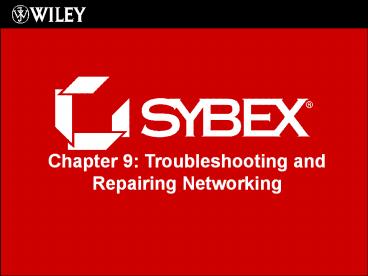Chapter 9: Troubleshooting and Repairing Networking - PowerPoint PPT Presentation
1 / 13
Title:
Chapter 9: Troubleshooting and Repairing Networking
Description:
... s/_rels/3.xml.rels ppt/s/_rels/1.xml.rels ppt/s/_rels ... ppt/s/9.xml ppt/s/1.xml ppt/s/10.xml ppt ... – PowerPoint PPT presentation
Number of Views:23
Avg rating:3.0/5.0
Title: Chapter 9: Troubleshooting and Repairing Networking
1
Chapter 9 Troubleshooting and Repairing
Networking
2
Troubleshooting Network Protocols
- 3 types of problems
- Software Most often a configuration problem
- Physical A failed NIC or cable
- External problems Failures of network devices
such as routers - Use ping.exe and tracert.exe
3
Troubleshooting Network Services at the Client
- Troubleshooting DNS
- Verify DNS Configuration
- Use nslookup.exe
- Troubleshooting DHCP
- Ipconfig.exe
- /release
- /renew
4
Troubleshooting Remote Access
- VPN Connections
- Remote Desktop
- Remote Assistance
5
Troubleshooting VPN Connections
- Check for Internet access
- Verify there is no firewall blocking VPN
- Verify VPN settings
- Server name or address
- Security settings
- Network settings
6
Troubleshooting Remote Desktop
- Check for firewall
- Verify general connectivity to the destination
machine - Is the host using NLA?
7
Troubleshooting Remote Assistance
- Invitation files
- Invitation Session
- Windows Vista only session?
- Verify the Offer Remote Assistance Helpers group
8
Troubleshooting Wireless Networking
- Verify settings
- SSID
- Wireless Security
- Signal Issues
- Too far from access point
- Too many walls
- Electronic Interference
- Application Log
9
Troubleshooting Network Security
- Network Access Protection Issues
- DHCP-NAP
- Restricted State
- Event log errors from NAP Agent Service
- Verify Connectivity to NAP Server
10
Troubleshooting Windows Firewall
- Firewall blocking incorrect apps
- Use command netsh firewall show state
verboseenable - Check public vs. private network
11
Using the Network Connection Diagnostics Tool
- Based on the Network Diagnostics Framework
- Automatically detects common network problems
- Can often repair automatically
12
Access to Network Resources
- Files and Folders
- Share permissions
- Firewall blocking
- Hidden and administrative shares
- Access to Printers
- Permissions
- Drivers
- Enable printer sharing
13
Configuring Network Discovery and Sharing
- Network and Sharing Center
- Based on public vs. private network profile
- Network Discovery allows machines to be seen
- LLTD allows building of network map































